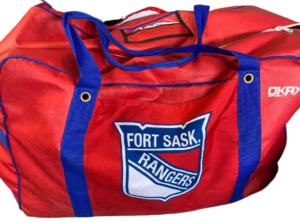
Like a defenseman silently doing their job thwarting every counter attack, hockey bags are the quiet heroes of hockey gear. You won’t think much of your average bag, you’ll really appreciate it when you have a great bag, and you’ll feel the pain when you have a bad one. So while you may drool over new sticks, new skates, and even new pads, keep in mind that hockey bags protect your gear, get you to the ice and back home daily, and keep you comfortable and relatively low-stink while doing it all.
What Makes a Good Hockey Bag?
Consider these key variables when you’re purchasing a new hockey bag, or deciding whether your current bag is actually meeting your needs. Your hockey bag should:
- Fit comfortably
- Be the right size
- Be strong enough to last more than a season
- Ventilate and reduce odors
Hockey Bag Fit & Size
Choosing the right size and fit in a hockey bag should be your starting point when shopping for a new one. The two most important factors to consider are whether the bag is big enough to hold all of your gear (but not so big that it’s cumbersome), and whether the straps are comfortable enough for toting that gear around two, three, or five days a week. It’s common for kids and beginners to lug around bags that are far too big for their needs, which, in the best case is super annoying for the player having to carry it, and at worst can strain a shoulder.
Not only should you consider how the bag fits you, but how the bag fits your gear. Is there enough room for all of the gear you carry regularly? Are there enough compartments to separate your gear? Is your bag padded in the right places to protect your most important gear? Many new bags come with dedicated skate compartments, and smaller compartments for things like mouth guards, to keep those accessories secure and separated from everything else that may be bouncing around in your bag.
Wheeled Bags vs. Carry Bags vs. Backpack Equipment Bags
Part of finding the right “fit” is choosing which style bag will best work for your needs. Carry bags with shoulder straps are the classic style hockey bags and continue to be the most popular, but wheeled bags and backpack-style equipment bags show up in locker rooms as well. Which one you choose is your own preference, but even if you’re a carry bag diehard, you still might want to check out wheeled bags and backpack equipment bags for some of their benefits.
While wheeled bags seem to be more popular for youths (taking the strain off of their shoulders) and goalies (who have to lug a ton of gear everywhere), they certainly take up more space in a small dressing room, and can't be stored away under the bench when you're all dressed and ready for that pre-game speech. That said, wheeled bags pull double duty, as most (if not all) have a shoulder carry option built in, so you can always shoulder carry a wheeled bag when you need to. The rest of the time you can pull or push your bag like you would your airline luggage, which takes the stress off your shoulders and allows you to easily weave through crowded lobbies at the rink, without the double girth of a giant bag hanging at hip height.
Backpack equipment bags make a great option for players who travel light. The biggest backpack-style hockey bags are nowhere near as big as the biggest carry bags and wheeled bags, but they can still carry the necessities, especially for younger, smaller players. And many come with wheels, bridging the gap between a small wheeled bag and a backpack-style equipment bag.
More Ventilation = Less Stink
Hockey bags don’t cause “rink stink” but a poorly ventilated bag can contribute to and harbor an unnecessary amount of stink. Newer bags are constructed of synthetic materials like polyester, which dries quickly and allows more air to move through the bag than older leather bags or even those made from polyvinyl (a synthetic leather). Polyester thread not only ventilates better, but with stronger threads like 600D, it also holds up better to the wear and tear of daily use. But a single tightly-woven fabric will breathe less (trapping more odor) than a bag with mesh panels. Manufacturers of bags like the Grit Airbox solve this by combining 600D panels for strength and durability, with large areas of mesh for maximum breathability, limiting the stink buildup between the locker room and home, where you can let your gear dry out.
